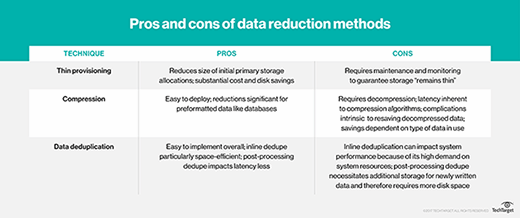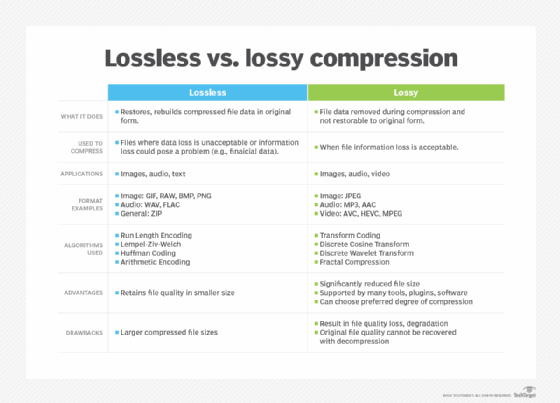lossless and lossy compression
What are lossless and lossy compression?
Lossless and lossy file compression describe whether all original data can be recovered when the file is uncompressed.
With lossless compression, every bit of data originally in a file remains after it is uncompressed, and all the information is restored. Lossy compression reduces a file by permanently eliminating certain information, especially redundant information.
When the file is uncompressed, some of the original information is not there, although the user may not notice it.
What is file compression?
Digital files such as image files are often "compressed" to reduce their size and/or to change various attributes, such as:
- file type
- dimensions
- resolution
- bit depth
Compression reduces the size of a file, often without appreciable loss of information. It can be either lossless or lossy.
A smaller-sized compressed file can be restored to its larger form -- in its entirety or with some data loss, depending on the compression type -- by decompression.
Lossless compression vs. lossy compression
Lossless compression restores and rebuilds file data in its original form after the file is decompressed. For example, when a picture's file size is compressed, its quality remains the same.
The file can be decompressed to its original quality without any loss of data. This compression method is also known as reversible compression.
With this method, although file sizes are reduced, the reduction is less compared to reduction using lossy compression.
In lossy compression, the data in a file is removed and not restored to its original form after decompression. Specifically, data is permanently removed, which is why this method is also known as irreversible compression.
This data loss is not usually noticeable. However, the more a file is compressed, the more degradation occurs, and the loss eventually becomes visible.
Lossy compression reduces file size much more than the file size achieved after lossless compression.

Applications of lossless and lossy compression
Lossless compression is mainly used to compress:
- images
- sound
- text
It is generally the technique of choice for detailed product images, photography showcases, text files and spreadsheet files, where the loss of picture quality, words or data (e.g., financial data) could pose a problem.
The Graphics Interchange File (GIF), an image format used on the internet, is generally compressed using lossless compression. RAW, BMP and PNG are also lossless image formats.
Lossy compression is mainly used to compress:
- images
- audio
- video
This technique is preferred for audio and video files where some amount of information loss is acceptable since it's unlikely to be detected by most users. The JPEG image file, commonly used for photographs and other complex still images on the web with no transparency, is generally compressed using lossy compression.
Using JPEG compression, the creator can decide how much loss to introduce, and how much of a trade-off is acceptable between file size and image quality.
Lossy compression is also suitable for websites featuring JPEG files and fast loading times since the compression ratio can be adjusted while maintaining the right balance.
Algorithms used in lossless and lossy compression
Different kinds of algorithms are used to reduce file sizes in lossless and lossy compression.
The algorithms used in lossless compression are:
The algorithms used in lossy compression are:
- Transform Coding
- Discrete Cosine Transform
- Discrete Wavelet Transform
- Fractal Compression
Advantages and drawbacks of lossless compression
The key benefit of lossless compression is that the quality of the file (e.g., an image) can be retained while achieving a smaller file size.
In JPEG and PNG files, this is done by removing unnecessary metadata. For applications where it's important to retain the quality of the file, lossless compression is the better choice.
The drawback of this compression technique is that larger file sizes are required to maintain post-compression quality.
Advantages and drawbacks of lossy compression
Lossy compression results in a significantly reduced file size (smaller than lossless compression), which is its most noteworthy benefit. It is supported by many tools, plugins and software products that let the user choose their preferred degree of compression.
The disadvantage is that it also results in quality loss, which may not be acceptable for some applications or users. The higher the compression ratio, the more quality degradation. Additionally, the original file -- with original quality -- cannot be recovered after compressing.

What is the best choice for compression: Lossless or lossy?
There is no "right" or "best" answer when it comes to choosing between lossless vs. lossy compression. The choice depends on:
- the application
- acceptable level of quality loss
- desired file size
So, for example, a blog or portfolio website could benefit from lossy compression since it offers significant file size reduction, saves storage space and improves site Performance and user experience. On the other hand, a website that requires high-quality photos would be better off with lossless compression.
It is also possible to use both types of compression for the same application.
